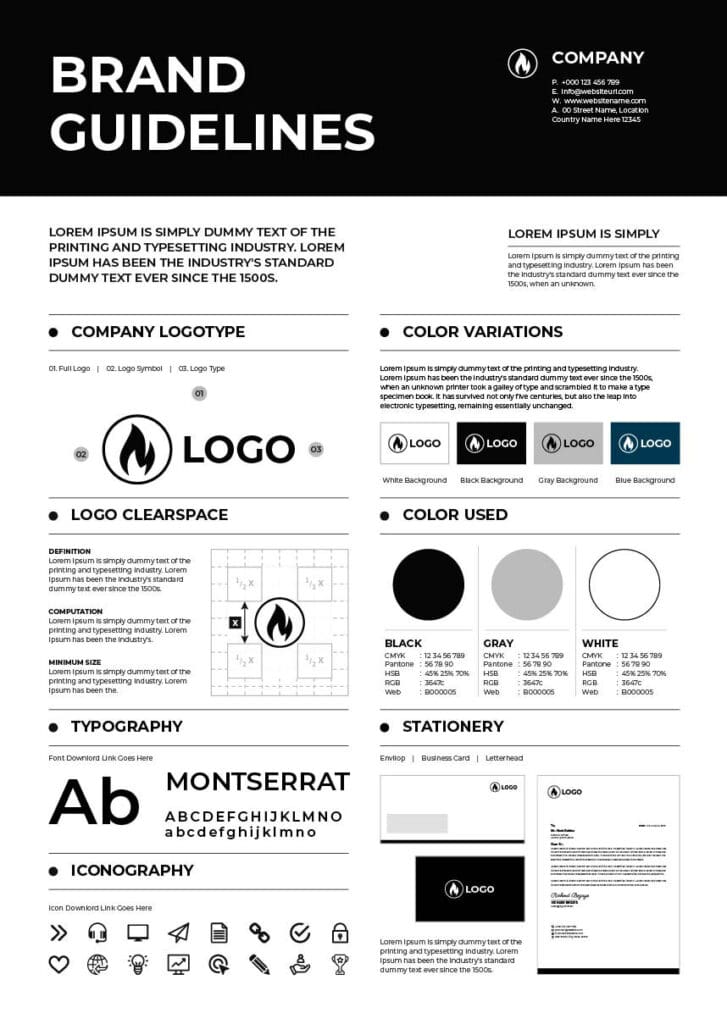
Branding is the process of creating a unique identity and image for a product, service, company, or individual in the minds of consumers. It involves crafting a distinct name, logo, design, and messaging that sets the entity apart from competitors and communicates its values, mission, and personality. Effective branding helps to establish trust, loyalty, and recognition among customers, ultimately influencing their purchasing decisions and fostering a strong connection between the brand and its audience. It’s about shaping perceptions and emotions to create a lasting impression. So why is branding important?
Branding is important for several reasons:
- Differentiation: In a crowded marketplace, branding helps a product or company stand out from competitors by communicating its unique qualities and value proposition.
- Recognition: Strong branding creates a memorable impression, making it easier for customers to recognize and remember the product or company amidst a sea of options.
- Trust and Credibility: A well-established brand conveys reliability, quality, and consistency, which fosters trust among consumers and encourages repeat purchases.
- Customer Loyalty: Brands that resonate with consumers on a deeper level tend to cultivate loyal followers who not only continue to purchase but also advocate for the brand to others.
- Price Premium: A strong brand allows companies to charge a premium for their products or services, as consumers are often willing to pay more for brands they perceive as superior or more prestigious.
- Emotional Connection: Brands that evoke positive emotions or align with consumers’ values can forge a deeper connection, fostering long-term relationships with customers.
- Market Positioning: Effective branding helps define a company’s position in the market, whether it’s as a leader in innovation, a provider of affordable solutions, or a luxury option catering to a niche audience.
Overall, branding is essential for building and sustaining a successful business, as it influences how customers perceive, engage with, and remain loyal to a product or company.
Ok, so I’ve convinced you that branding is important and you are ready to get started. What next? First, you need to establish your brand guidelines and create a style guide.
What is a style guide?
A style guide for a business, also known as a brand style guide or brand guidelines, is a comprehensive document that outlines the rules and specifications for how the brand should be presented across various channels and mediums. It serves as a reference tool to ensure consistency in branding elements and messaging, both internally among employees and externally with customers and partners. Here are the key components typically included in a business style guide:
Elements to incorporate into your style guide include:
- Brand Identity: This section defines the core elements of the brand identity, including the brand name, logo, tagline (if applicable), and brand colors. It provides guidelines for how these elements should be used and displayed in different contexts.
- Typography: Specifies the fonts and typography styles to be used in various communications, including headings, body text, and other design elements. It may include guidelines for font sizes, weights, and spacing.
- Color Palette: Presents the approved color palette for the brand, including primary, secondary, and accent colors. It provides color codes (e.g., RGB, CMYK, HEX) for both print and digital applications and guidelines for color usage and combinations.
- Imagery and Photography: Provides guidance on the types of imagery and photography that align with the brand’s visual identity. It may include examples of preferred imagery styles, compositions, and subject matter, as well as rules for image usage and sourcing.
- Voice and Tone: Defines the brand’s voice and tone, including its personality, language style, and communication approach. It outlines guidelines for writing and speaking in a manner consistent with the brand’s values and target audience.
- Messaging and Positioning: Articulates the brand’s key messages, value proposition, and positioning in the market. It may include examples of brand messaging for different audiences and scenarios, as well as guidelines for maintaining consistency in communication.
- Logo Usage and Placement: Specifies rules for the usage, placement, and sizing of the brand logo across various applications, such as print materials, digital platforms, and merchandise. It may include guidelines for clear space, minimum size, and acceptable alterations.
- Visual Elements and Design Standards: Provides direction on the use of visual elements and design standards, such as graphic patterns, icons, textures, and layouts. It may include templates and examples to ensure consistency in design across different assets.
- Usage Guidelines and Best Practices: Offers general usage guidelines and best practices for applying the brand style guide in different contexts, such as marketing materials, advertising campaigns, packaging, websites, and social media.
- Brand Examples: Includes examples of branded materials and communications that demonstrate how the brand style guide should be applied in practice.

How to Implement your Style Guide on your website
There are several things you need to do to make sure that your website is incorporating your brand. Use your style guide to make sure you are doing all the following:
Logo: Make sure you are using the most up-to-date version of your logo throughout your website, including in the header and footer, and on any other elements that have the logo. Use a high quality version.
Typography: Make sure your website is using the fonts that are designated in the style guide. You should have established a primary font for your headings and a primary font for your text. This should be used throughout all website elements, and should continue in your offline marketing as well.
Color Palette: Use the approved color palette for the brand, including primary, secondary, and accent colors throughout your website, which could include the navigation, fonts, headings, and other visual elements like buttons, etc.
Imagery and Photography: Use high quality images that reinforce your brand.
Content Guidelines: Define the voice, tone, and style of website content to ensure consistency with the brand’s messaging. It shouldn’t jump from formal one one page to casual on another.
Using your Style Guide for Offline Marketing
Using a style guide for offline marketing involves applying the same principles of consistency and adherence to brand guidelines across various printed materials and physical touchpoints. Here’s how to effectively use a style guide for offline marketing:
- Print Collateral: Ensure that all printed materials, such as brochures, flyers, business cards, and stationery, adhere to the brand’s visual identity as outlined in the style guide. Use consistent typography, color palette, and imagery to maintain brand coherence.
- Signage and Displays: Design signage, banners, posters, and other displays in alignment with the brand’s visual identity. Use branded colors, fonts, and imagery to reinforce brand recognition and create a cohesive brand experience in physical spaces.
- Packaging Design: Apply the brand’s visual identity to product packaging and labeling. Use consistent design elements, such as logos, colors, and typography, to create a recognizable brand presence on store shelves and in consumers’ homes.
- Event Branding: Ensure that branding elements are prominently featured at corporate events, trade shows, conferences, and other offline events. Use branded signage, banners, booth designs, and promotional materials to reinforce brand visibility and messaging.
- Vehicle Branding: If applicable, apply branding elements to company vehicles, such as cars, trucks, or vans. Use vehicle wraps, decals, or magnetic signs to display the brand logo, colors, and messaging while on the road or parked in public spaces.
- Uniforms and Apparel: If employees wear uniforms or branded apparel, ensure that the design aligns with the brand’s visual identity. Use consistent colors, logos, and typography to create a professional and cohesive brand image.
- Merchandise and Promotional Items: Apply branding elements to merchandise and promotional items, such as branded merchandise, giveaways, and corporate gifts. Use consistent design elements to create memorable brand experiences for recipients.
- Environmental Branding: Consider environmental branding elements, such as interior decor, signage, and displays in physical locations like offices, stores, or event venues. Use branded graphics, imagery, and messaging to create a cohesive brand atmosphere.
- Photography and Videography: Ensure that photography and videography used in offline marketing materials align with the brand’s visual identity. Use consistent styles, compositions, and subject matter to convey the brand’s personality and values.
- Compliance and Quality Control: Regularly review offline marketing materials to ensure compliance with the style guide and maintain consistency in branding across all touchpoints. Conduct quality control checks to identify any deviations from brand guidelines and make necessary corrections.
By leveraging a style guide for online and offline marketing efforts, businesses can maintain consistency, professionalism, and brand coherence across all platforms and printed materials, physical touch-points, and offline interactions with customers and stakeholders.
Amy Masson
Amy is the co-owner, developer, and website strategist for Sumy Designs. She's been making websites with WordPress since 2006 and is passionate about making sure websites are as functional as they are beautiful.
